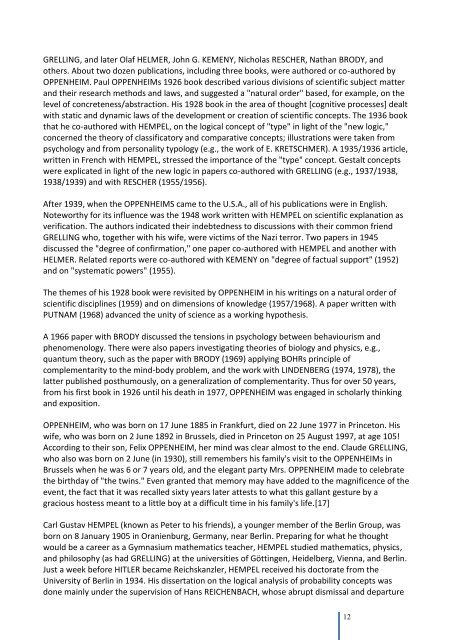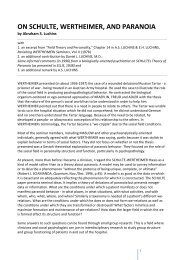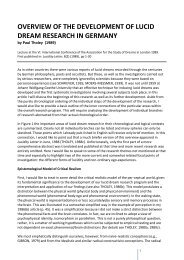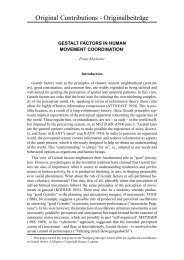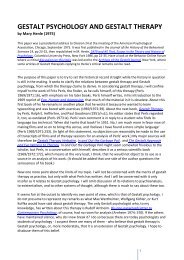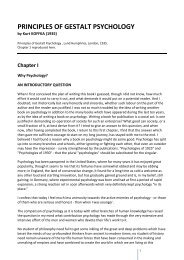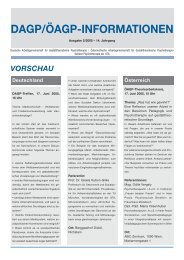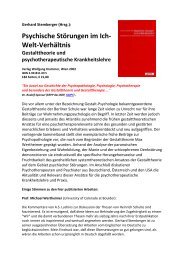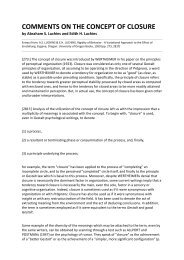pdf-Download - Society for Gestalt Theory and its Applications (GTA)
pdf-Download - Society for Gestalt Theory and its Applications (GTA)
pdf-Download - Society for Gestalt Theory and its Applications (GTA)
Create successful ePaper yourself
Turn your PDF publications into a flip-book with our unique Google optimized e-Paper software.
GRELLING, <strong>and</strong> later Olaf HELMER, John G. KEMENY, Nicholas RESCHER, Nathan BRODY, <strong>and</strong><br />
others. About two dozen publications, including three books, were authored or co-authored by<br />
OPPENHEIM. Paul OPPENHEIMs 1926 book described various divisions of scientific subject matter<br />
<strong>and</strong> their research methods <strong>and</strong> laws, <strong>and</strong> suggested a "natural order" based, <strong>for</strong> example, on the<br />
level of concreteness/abstraction. His 1928 book in the area of thought [cognitive processes] dealt<br />
with static <strong>and</strong> dynamic laws of the development or creation of scientific concepts. The 1936 book<br />
that he co-authored with HEMPEL, on the logical concept of "type" in light of the "new logic,"<br />
concerned the theory of classificatory <strong>and</strong> comparative concepts; illustrations were taken from<br />
psychology <strong>and</strong> from personality typology (e.g., the work of E. KRETSCHMER). A 1935/1936 article,<br />
written in French with HEMPEL, stressed the importance of the "type" concept. <strong>Gestalt</strong> concepts<br />
were explicated in light of the new logic in papers co-authored with GRELLING (e.g., 1937/1938,<br />
1938/1939) <strong>and</strong> with RESCHER (1955/1956).<br />
After 1939, when the OPPENHEIMS came to the U.S.A., all of his publications were in English.<br />
Noteworthy <strong>for</strong> <strong>its</strong> influence was the 1948 work written with HEMPEL on scientific explanation as<br />
verification. The authors indicated their indebtedness to discussions with their common friend<br />
GRELLING who, together with his wife, were victims of the Nazi terror. Two papers in 1945<br />
discussed the "degree of confirmation," one paper co-authored with HEMPEL <strong>and</strong> another with<br />
HELMER. Related reports were co-authored with KEMENY on "degree of factual support" (1952)<br />
<strong>and</strong> on "systematic powers" (1955).<br />
The themes of his 1928 book were revisited by OPPENHEIM in his writings on a natural order of<br />
scientific disciplines (1959) <strong>and</strong> on dimensions of knowledge (1957/1968). A paper written with<br />
PUTNAM (1968) advanced the unity of science as a working hypothesis.<br />
A 1966 paper with BRODY discussed the tensions in psychology between behaviourism <strong>and</strong><br />
phenomenology. There were also papers investigating theories of biology <strong>and</strong> physics, e.g.,<br />
quantum theory, such as the paper with BRODY (1969) applying BOHRs principle of<br />
complementarity to the mind-body problem, <strong>and</strong> the work with LINDENBERG (1974, 1978), the<br />
latter published posthumously, on a generalization of complementarity. Thus <strong>for</strong> over 50 years,<br />
from his first book in 1926 until his death in 1977, OPPENHEIM was engaged in scholarly thinking<br />
<strong>and</strong> exposition.<br />
OPPENHEIM, who was born on 17 June 1885 in Frankfurt, died on 22 June 1977 in Princeton. His<br />
wife, who was born on 2 June 1892 in Brussels, died in Princeton on 25 August 1997, at age 105!<br />
According to their son, Felix OPPENHEIM, her mind was clear almost to the end. Claude GRELLING,<br />
who also was born on 2 June (in 1930), still remembers his family's visit to the OPPENHEIMs in<br />
Brussels when he was 6 or 7 years old, <strong>and</strong> the elegant party Mrs. OPPENHEIM made to celebrate<br />
the birthday of "the twins." Even granted that memory may have added to the magnificence of the<br />
event, the fact that it was recalled sixty years later attests to what this gallant gesture by a<br />
gracious hostess meant to a little boy at a difficult time in his family's life.[17]<br />
Carl Gustav HEMPEL (known as Peter to his friends), a younger member of the Berlin Group, was<br />
born on 8 January 1905 in Oranienburg, Germany, near Berlin. Preparing <strong>for</strong> what he thought<br />
would be a career as a Gymnasium mathematics teacher, HEMPEL studied mathematics, physics,<br />
<strong>and</strong> philosophy (as had GRELLING) at the universities of Göttingen, Heidelberg, Vienna, <strong>and</strong> Berlin.<br />
Just a week be<strong>for</strong>e HITLER became Reichskanzler, HEMPEL received his doctorate from the<br />
University of Berlin in 1934. His dissertation on the logical analysis of probability concepts was<br />
done mainly under the supervision of Hans REICHENBACH, whose abrupt dismissal <strong>and</strong> departure<br />
12


